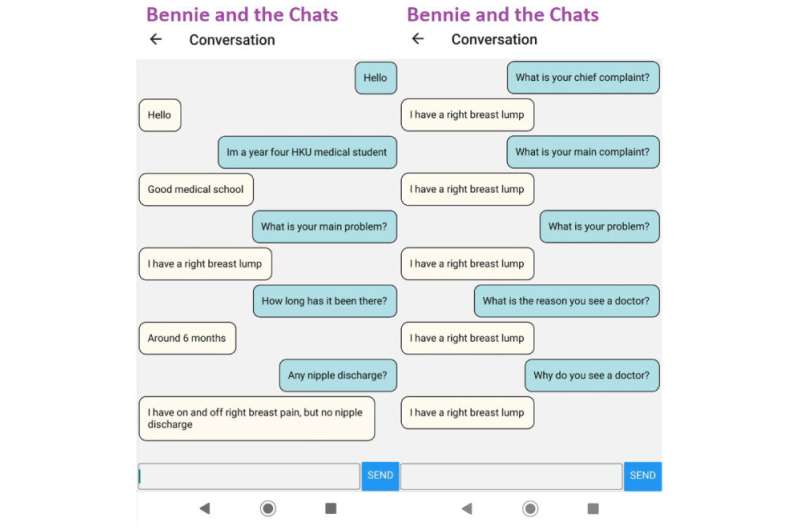This article has been reviewed according to Science X's editorial process and policies. Editors have highlighted the following attributes while ensuring the content's credibility:
fact-checked
peer-reviewed publication
trusted source
proofread
'AI virtual patients' diagnostic application breaks spatial and geographical barriers for medical training

With the rapid development and extensive applications of generative artificial intelligence (AI) technology across various sectors, Dr. Michael Co Tiong-hong from the LKS Faculty of Medicine, the University of Hong Kong (HKUMed), and Dr. John Yuen Tsz-hon from the Department of Computer Science, HKU, have jointly developed Hong Kong's first "AI virtual patients" diagnostic application for training medical students.
Leveraging generative AI technology and real-life surgical cases, the research team has designed "humanized" AI virtual patients with distinct personalities and medical histories, which allow medical students to virtually simulate interactions with patients during bedside consultations. This initiative greatly enhances the students' professional skills and ability to accurately gather patients' medical history.
To provide students with a more diverse range of clinical learning opportunities, HKUMed collaborated with the National University of Singapore (NUS) to introduce cross-regional medical cases in the diagnostic app. This revolutionary approach has redefined traditional medical teaching methods. Looking ahead, HKUMed also plans to collaborate with other overseas medical schools.
The virtual mode of clinical teaching provides personalized patient cases tailored to the specific needs of individual medical students. In 2020, Dr. Co and Dr. Yuen initiated the development of an AI chatbot to help HKUMed students who could not attend hospital-based classes amid the pandemic. In 2021, a system prototype was available for trial with a selected group of HKUMed students. Teachers could design virtual patients suited to each student's diagnostic skill level. Students would compile the medical records for case discussions and analysis with their teachers. In 2022, the outcomes of this innovative teaching mode were published in Heliyon.
Through continuous research and improvement, the HKU team developed Hong Kong's first "AI virtual patients" diagnostic application. Integrated with generative AI technology, the latest model of the chatbot goes beyond standardized and monotonous replies, providing highly dynamic and lively responses. Even for the same medical case, the AI virtual patient is capable of providing distinct responses, interacting with students in a remarkably human-like and personality-driven manner.
Significance and Impact
This innovative virtual clinical teaching mode provides personalized teaching cases with equal access for all students, and addresses the limitations of the traditional teaching mode. Dr. Co explained, "Traditional clinical teaching relies heavily on in-person interaction with real patients. But for various reasons, like scheduling difficulties, not all medical students have equal opportunities to engage in face-to-face consultations. The 'AI virtual patients' app allows us to overcome time and geographical barriers, offering our students access to practice with rare cases and providing them with invaluable clinical experience. Through a virtual learning environment, equipped with a wide range of diverse patient cases, medical students can enhance their patient history-taking skills and improve the accuracy of their diagnoses."
Dr. John Yuen Tsz-hon, from the Department of Computer Science, HKU, said, "The 'AI virtual patients' app has the capacity to accumulate information, resulting in each response it generates having a slight variation in tone and wording. This enables more authentic interactions between doctors and virtual patients. Additionally, teachers can utilize the data collected by the system to conduct in-depth analysis and assessment of students' performance, which allows them to provide specific feedback and guidance to individual students, ultimately enhancing the efficiency of clinical teaching."
Virtual clinical teaching can remove spatial and geographical barriers, fostering international exchange in medical education. In early October this year, Dr. Co collaborated with Dr. Serene Goh, a specialist surgeon from the National University of Singapore, to launch the world's first cross-regional virtual clinical teaching program. The two doctors devised distinct patient cases for students in their respective locations to practice consultations utilizing the 'AI virtual patients' app. Through online case discussions, the medical students jointly analyzed patients' imaging studies, endoscopic images and pathological slides in online case discussions.
"Collaboration and exchange with medical schools in other regions will enable medical students to learn from each other's strengths, broaden their horizons and knowledge, and promote international cooperation and development in medical education. This will set the foundation for boundless educational innovations in the future," Dr. Co added.




















